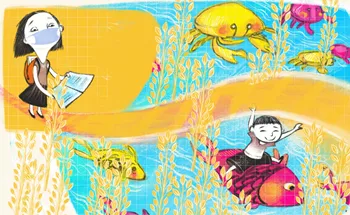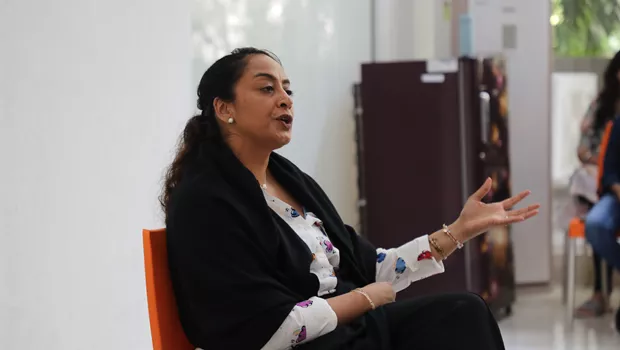What we learned at ‘Diversity of Diversity: The Power of Books in Fostering Diverse Communities’
June 16, 2021

There’s a paradox built into our idea of “diversity” - on one hand, the human experience is so multilayered and complex, you can never truly capture it. We try with the usual groupings - race, gender, religion, caste, abilities, culture, economic status, sexual orientation, etc. - but even that list is endless and that’s before looking at the ways those identity markers intersect to make unique individuals. On the other hand, you have the power of the specific. Storytellers know that it is the details, not the generalities that sing, that invite empathy, that make a character real. So how do we promote a shared humanity without erasing the beautiful differences that define it?
Room to Read recently convened thought leaders, authors and publishers for an online event to discuss the spectrum of identities and representation in literature, “Diversity of Diversity: The Power of Books in Fostering Diverse Communities.” Focusing on literacy and gender-equality in education, we at Room to Read know the power of books and stories in young people’s lives - their ability to bridge divides, amplify voices and remove barriers in society, ultimately building a more inclusive, unifying and empathetic world.
Below we share six takeaways from our discussion on how diverse books help us better understand “the particular and universal needs of ourselves and others.”

At Room to Read, we believe World Change Starts with Educated Children - and reading can transform a person’s life. At “Diversity of Diversity,” Room to Read CEO Dr. Geetha Murali reminded us that, “Reading helps us empathize and better understand those around us. Books are windows to the experiences of others and mirrors that reflect back and validate our own experiences.”
At this moment, those positive effects are as important as ever. As Dr. Murali said, “Books and literature also are a source of stability, comfort and hope for young people, and we see that dynamic playing out now as a new catastrophic wave of COVID-19 makes its way through India, where we have more than 600 of our 1,600 employees. Amid this turbulence, Room to Read is actively ensuring that education endures… lifts people up and helps them choose their own futures.” Such is the power of books.

Different books will speak to different people so we need our library shelves to be as diverse and dynamic as our communities. Senior Director of Global Literacy Programs at Room to Read Christabel Pinto put it best when she said at the event, “Diverse literature motivates readers. In particular, I'm thinking of reluctant readers because those are the ones we worry about. But really, it motivates all readers. We never really know which particular book is going to light which particular child's fire. So having a diverse collection ensures that we reach as many children as possible, so as many kids [as possible] can find at least one book that resonates with them. And that can motivate them to pick up another book and yet another book and become lifelong readers.”

However, this diversity in books is not happening organically on its own. Literary agent and President of DiverseVoices, Inc. Beth Phelan told us, “Publishing in general is very white, cis het, and non-disabled. It’s very homogeneous [and] this sends a message to marginalized voices that they’re not welcome.” Elin Williams, writer of the award-winning My Blurred World blog, agreed, “What strikes me is the lack of representation of disabled people in literature. Let me ask you a few questions: How many books have you read by disabled authors? How many books have you read with a disabled protagonist? And how many books have you read with that disabled character portrayed in an honest and positive light?” In response to these inequities, Phelan created DiverseVoices to push the industry to be “better allies - dismantle this systemic issue, educate themselves and each other, and create space at the table… I want to see marginalized people behind the books, not just in them.”
This bias goes all the way to the very language of the book itself. To help overcome this issue, Room to Read has partnered with Librio, an innovative personalized publishing company, since 2018 to create books “in languages otherwise overlooked by traditional publishers,” as Librio CEO Ed Russell told us at “Diversity of Diversity.” He explained, “there's a huge difference for a child to have a book in a language that it can speak and a book in a language that it does actually speak.” Room to Read’s Literacy Program Manager for Southeast Asia Alfredo Santos agreed, saying “I think language is the single most powerful element of diversity that is contained in our books. To be able to read in your own language and to see your words reflected in the books that you read is such a powerful, affirming experience for many of our readers, and for our writers and illustrators as well.”

While we urge publishing at large to catch up in theme, format, and language, Room to Read creates our own books that speak directly to the lives of the young readers we work with. Alison Ziki, Room to Read’s Literacy Manager for Africa, told us that for him, that means creating stories uplifting the Albino community in one country while focusing on women’s voices in another and uplifting different religious traditions in still another. He spoke of the importance of this diversity, noting how for example, today’s diverse books act as “a corrective'' against the legacy of aparthied in South Africa, creating an “affirming” effect. Mahesh Pathirathna, Associate Director of Literacy in Sri Lanka, echoed his colleague, declaring, “publishing books with the element of diversity is really helpful for children to understand others in our own, very multicultural community.”

Dr. Maya Soetoro-Ng, Peace Educator and Advisor to the Obama Foundation, got to the heart of the matter, saying, “Diverse stories are windows, offering young people views of worlds that may be real or imagined, familiar or fantastic, so that young people can understand the complexity of human life and relationships… Let’s make sure that as they grow, they have access to stories that widen wonder so that they never get trapped in small spaces.”
Jennifer Phillips, author of "The Invitation," part of Room to Read's Peace and Equality Collection, said her book looks at “how we deal with feeling uncomfortable or confused around somebody else and that goes for grown-ups as well as kids... It is about getting out of our comfort zone and how that can lead to great experiences and even friendships.” Dr. Soetoro-Ng further explained the importance of books like "The Invitation" with this: “Writers, illustrators and creatives of all kinds build empathy so that [readers] are moved to work for peace and justice… Later as they experience the pain of their own conflicts and communities, they will be poised to find their way out of rage and grief to determination and growth. They will be better prepared to see and nourish solutions for themselves, their families and communities.”

Senior Vice President and Publisher at Scholastic International Dr. Duriya Aziz SW shared this story on “the power and ability of youth,” further proving that change starts and ends with young people: “My five-year-old granddaughter Rukaya convinced her kindergarten teacher to hold an Eid al-Fitr celebration in school similar to the Chinese New Year celebration they had had earlier in the year. She even took on the responsibility of bringing decorations, cookies and tokens to school. I'm so glad that her teacher not only agreed but went on to hold a lovely celebration. What a positive impact this must have on Rukaya's sense of self, her identity as a young muslim girl, as a member of a preschool group, as a Singaporean and her sense of personal, social and national identity.” Literacy, diverse books and gender-equality in education create countless stories like these, changing the world through educated children, who are ready to reach their potential and bring their communities along with them.



